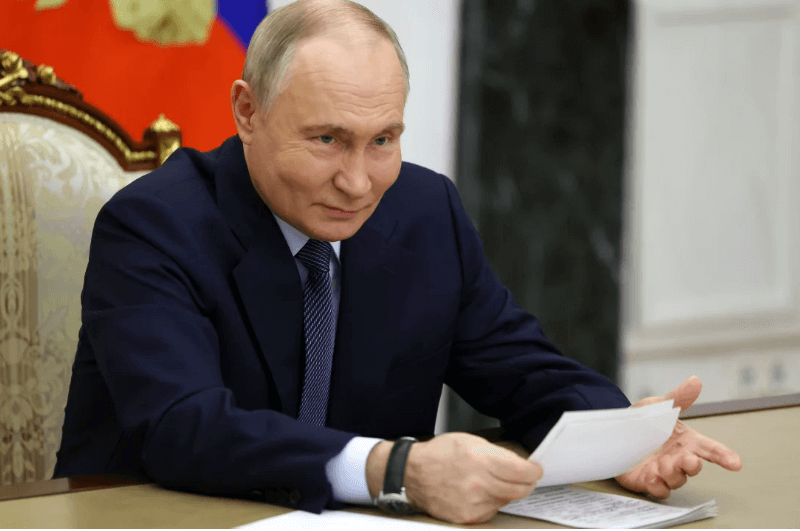北约和乌克兰将在俄罗斯使用新型高超音速导弹袭击后举行紧急会谈

【中美创新时报2024 年 11 月 23 日编译讯】(记者温友平编译)北约和乌克兰将于周二举行紧急会谈,此前俄罗斯使用一枚实验性的高超音速弹道导弹袭击了一座中部城市,使这场持续近 33 个月的战争升级。美联社记者 ILLIA NOVIKOV 和 VOLODYMYR YURCHUK 对此作了下述报道。
波兰总理唐纳德·图斯克周五表示,这场冲突“正在进入决定性阶段”,并且“呈现出非常戏剧性的规模”。
乌克兰议会取消了一次会议,因为周四俄罗斯袭击了第聂伯罗市的一个军事设施后,乌克兰加强了安全措施。
总统弗拉基米尔·普京在全国电视讲话中向西方发出了严厉警告,称使用中程奥列什尼克导弹的袭击是对基辅使用能够深入俄罗斯领土的美国和英国远程导弹的报复。
普京表示,西方防空系统无力阻止这种新型导弹。

乌克兰军方官员表示,击中第聂伯罗的导弹速度达到 11 马赫,携带六枚非核弹头,每枚弹头可发射六枚子弹药。
周五,普京对军方和武器工业官员发表讲话时表示,俄罗斯正在启动“奥列什尼克”导弹的生产。
“世界上没有人拥有这种武器,”他微笑着说。“其他主要国家迟早也会拥有它们。我们知道它们正在开发中。”
但他补充说,“我们现在有这个系统。这很重要。”
普京表示,将继续测试导弹,“包括战斗测试,具体取决于俄罗斯面临的情况和安全威胁的性质”,并指出“有一批这样的系统随时可用。”
普京表示,虽然它不是洲际导弹,但威力如此强大,如果在一次攻击中使用多枚装有常规弹头的导弹,其破坏力可能不亚于战略武器或核武器的打击。
俄罗斯战略导弹部队负责人谢尔盖·卡拉卡耶夫将军表示,奥列什尼克导弹可以打击整个欧洲的目标,并配备核弹头或常规弹头,这与普京的说法相呼应,普京称,即使配备常规弹头,“大规模使用该武器的效果也堪比使用核武器。”
克里姆林宫发言人德米特里·佩斯科夫周五继续保持俄罗斯的好战语气,指责“西方国家鲁莽的决定和行动”,向乌克兰提供武器打击俄罗斯。
“俄罗斯方面已经清楚地展示了其能力,如果我们的担忧没有得到考虑,进一步报复行动的轮廓也已经非常明确,”他说。
匈牙利总理维克托·奥尔班被广泛认为是欧盟中与克里姆林宫关系最密切的总理,他呼应了莫斯科的观点,暗示在乌克兰使用美国提供的武器可能需要美国的直接参与。
“这些火箭发射后通过电子系统引导至目标,这需要世界上最先进的技术和卫星通信能力,”奥尔班在国家电台上说。“人们强烈认为……这些导弹如果没有美国人员的协助就无法制导。”
奥尔班警告不要低估俄罗斯的反应,强调该国最近对其核部署理论的修改不应被视为“虚张声势”。“这不是诡计……会有后果,”他说。
另外,在基辅,捷克外交部长扬·利帕夫斯基称周四的导弹袭击是“升级步骤,是俄罗斯独裁者恐吓乌克兰人民和欧洲人民的企图。”
在与乌克兰外交部长安德烈·西比哈举行的新闻发布会上,利帕夫斯基还表示全力支持提供必要的额外防空系统,以保护乌克兰平民免受“令人发指的袭击”。
他强调,捷克共和国不会限制使用其提供给乌克兰的武器和装备。
乌克兰议会最高拉达的三名议员证实,由于俄罗斯导弹持续威胁基辅市中心的政府大楼,周五原定的会议被取消。
此外,还有一项建议限制“该周边地区所有商业办公室和非政府组织的工作,并警告当地居民威胁加剧”,议员米基塔·波图拉耶夫说,她补充说,这并不是第一次收到这样的威胁。
一位发言人表示,总统泽连斯基的办公室继续按照标准安全措施开展工作。
乌克兰情报总局表示,这枚俄文名称为“榛子树”的奥列什尼克导弹是从俄罗斯阿斯特拉罕地区的卡普斯京亚尔第四导弹试验场发射的,飞行 15 分钟后击中了第聂伯罗。
该局表示,类似的导弹于 2023 年 10 月和 2024 年 6 月进行了试射。五角大楼证实,这枚导弹是一种新型实验型中程导弹,基于其 RS-26 Rubezh 洲际弹道导弹。
周四的袭击袭击了乌克兰在苏联时期制造洲际弹道导弹的 Pivdenmash 工厂。该军事设施位于第聂伯罗市中心西南约 4 英里处,第聂伯罗是乌克兰第四大城市,人口约 100 万,是军事物资和人道主义援助的重要枢纽,也是该国最大的医院之一,用于治疗从前线来的受伤士兵,然后转移到基辅或国外。
受灾地区被封锁,不对外开放。由于没有人员伤亡报告,第聂伯罗居民在社交媒体上玩起了黑色幽默,主要关注导弹的名字“奥列什尼克”。
乌克兰其他地方,俄罗斯夜间用伊朗设计的“沙赫德”无人机袭击了苏梅的一个居民区,造成 2 人死亡,13 人受伤,地区行政部门表示。
乌克兰 Suspilne 媒体援引苏梅地区负责人 Volodymyr Artiukh 的话称,无人机里装满了弹片。Suspilne 称,Artiukh 说:“这些武器是用来杀人的,不是用来毁物的。”
题图:俄罗斯总统弗拉基米尔·普京周五在莫斯科克里姆林宫会见俄罗斯国防部领导、军工联合体代表和导弹系统开发商时发表讲话。Vyacheslav Prokofyev/AP/Pool Sputnik 克里姆林宫
附原英文报道:
NATO and Ukraine to hold emergency talks after Russia’s attack with new hypersonic missile
By ILLIA NOVIKOV and VOLODYMYR YURCHUK The Associated Press,Updated November 22, 2024
KYIV — NATO and Ukraine will hold emergency talks Tuesday after Russia attacked a central city with an experimental, hypersonic ballistic missile that escalated the nearly 33-month-old war.
The conflict is “entering a decisive phase,” Poland’s Prime Minister Donald Tusk said Friday, and “taking on very dramatic dimensions.”
Ukraine’s parliament canceled a session as security was tightened following Thursday’s Russian strike on a military facility in the city of Dnipro.
In a stark warning to the West, President Vladimir Putin said in a nationally televised speech that the attack with the intermediate-range Oreshnik missile was in retaliation for Kyiv’s use of US and British longer-range missiles capable of striking deeper into Russian territory.
Putin said Western air defense systems would be powerless to stop the new missile.
Ukrainian military officials said the missile that hit Dnipro had reached a speed of Mach 11 and carried six nonnuclear warheads each releasing six submunitions.
Speaking Friday to military and weapons industries officials, Putin said Russia is launching production of the Oreshnik.
“No one in the world has such weapons,” he said with a thin smile. “Sooner or later other leading countries will also get them. We are aware that they are under development.”
But he added, “we have this system now. And this is important.”
Testing the missile will continue, “including in combat, depending on the situation and the character of security threats created for Russia,” Putin said, noting there is ”a stockpile of such systems ready for use.”
Putin said that while it isn’t an intercontinental missile, it’s so powerful that the use of several of them fitted with conventional warheads in one attack could be as devastating as a strike with strategic — or nuclear — weapons.
General Sergei Karakayev, head of Russia’s Strategic Missile Forces, said the Oreshnik could reach targets across Europe and be fitted with nuclear or conventional warheads, echoing Putin’s claim that even with conventional warheads, “the massive use of the weapon would be comparable in effect to the use of nuclear weapons.”
Kremlin spokesman Dmitry Peskov kept up Russia’s bellicose tone on Friday, blaming “the reckless decisions and actions of Western countries” in supplying weapons to Ukraine to strike Russia.
“The Russian side has clearly demonstrated its capabilities, and the contours of further retaliatory actions in the event that our concerns were not taken into account have also been quite clearly outlined,” he said.
Hungarian Prime Minister Viktor Orbán, widely seen as having the warmest relations with the Kremlin in the European Union, echoed Moscow’s talking points, suggesting the use of US-supplied weapons in Ukraine likely requires direct American involvement.
“These are rockets that are fired and then guided to a target via an electronic system, which requires the world’s most advanced technology and satellite communications capability,” Orbán said on state radio. “There is a strong assumption … that these missiles cannot be guided without the assistance of American personnel.”
Orbán cautioned against underestimating Russia’s responses, emphasizing that the country’s recent modifications to its nuclear deployment doctrine should not be dismissed as a “bluff.” “It’s not a trick … there will be consequences,” he said.
Separately in Kyiv, Czech Foreign Minister Jan Lipavský called Thursday’s missile strike an “escalatory step and an attempt of the Russian dictator to scare the population of Ukraine and to scare the population of Europe.”
At a news conference with Ukrainian Foreign Minister Andrii Sybiha, Lipavský also expressed his full support for delivering the necessary additional air defense systems to protect Ukrainian civilians from the “heinous attacks.”
He underlined that the Czech Republic will impose no limits on the use of its weapons and equipment given to Ukraine.
Three lawmakers from Ukraine’s parliament, the Verkhovna Rada, confirmed that Friday’s previously scheduled session was called off because of the ongoing threat of Russian missiles targeting government buildings in central Kyiv.
In addition, there also was a recommendation to limit the work of all commercial offices and nongovernmental organizations “in that perimeter, and local residents were warned of the increased threat,” said lawmaker Mykyta Poturaiev, who added this is not the first time such a threat has been received.
President Volodymyr Zelensky’s office continued to work in compliance with standard security measures, a spokesperson said.
Ukraine’s Main Intelligence Directorate said the Oreshnik missile, whose name in Russian means “hazelnut tree,” was fired from the Kapustin Yar 4th Missile Test Range in Russia’s Astrakhan region, and flew 15 minutes before striking Dnipro.
Test launches of a similar missile were conducted in October 2023 and June 2024, the directorate said. The Pentagon confirmed the missile was a new, experimental type of intermediate-range missile based on its RS-26 Rubezh intercontinental ballistic missile.
Thursday’s attack struck the Pivdenmash plant that built ICBMs when Ukraine was part of the Soviet Union. The military facility is located about 4 miles southwest of the center of Dnipro, a city of about 1 million that is Ukraine’s fourth-largest and a key hub for military supplies and humanitarian aid, and is home to one of the country’s largest hospitals for treating wounded soldiers from the front before their transfer to Kyiv or abroad.
The stricken area was cordoned off and out of public view. With no fatalities reported from the attack, Dnipro residents resorted to dark humor on social media, mostly focused on the missile’s name, Oreshnik.
Elsewhere in Ukraine, Russia struck a residential district of Sumy overnight with Iranian-designed Shahed drones, killing two people and injuring 13, the regional administration said..
Ukraine’s Suspilne media, quoting Sumy regional head Volodymyr Artiukh, said the drones were stuffed with shrapnel elements. “These weapons are used to destroy people, not to destroy objects,” said Artiukh, according to Suspilne.

